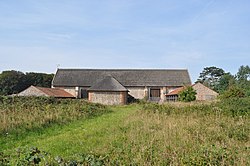Paston Great Barnis a medieval barn nearPaston Hallon the southeast edge of the village ofPastonin northeastNorfolk,owned by the North Norfolk Historic Buildings Trust. Dating from 1581, the building has a long association with thePaston family.Ascheduled monumentand a grade II*listed building,[1]the barn is the centre of a 0.95 hectares (2.3 acres) biologicalSite of Special Scientific Interest,[2][3]aNational Nature Reserve[4]and aSpecial Area of Conservation.[5]It is in theNorfolk CoastArea of Outstanding Natural Beauty.[6]
| Paston Great Barn | |
|---|---|
 The Barn in 2010 | |
| Type | Barn |
| Location | Paston |
| Coordinates | 52°51′25″N1°26′51″E/ 52.85698°N 1.44760°E |
| OS grid reference | TG 32192 34539 |
| Area | Norfolk |
| Built | 1581 |
| Governing body | Natural England |
| Owner | North Norfolk Historic Buildings Trust |
Listed Building– Grade II* | |
| Official name | Paston Great Barn |
| Designated | 16 April 1955 |
| Reference no. | 1306240 |
| Official name | Great Barn, Paston |
| Reference no. | 1002884 |
The barn
editThe barn is a long, low building, with athatched roof,and walls built ofbrick,flintandlimestone,with large doors with timberlintels.The barn was commissioned by Sir William Paston III as a grain store and threshing barn. It is approximately 70 metres (230 ft) long, 9 metres (30 ft) wide and 16 metres (52 ft) high. It has been granted Grade II* listed building status byEnglish Heritagedue to its architectural and historical importance. There are three 30 metres (98 ft) long Victorian wings on the eastern side of the barn, added to house cattle. Unusually for a barn it has two date stones, one over an entrance and one in a gable end.[7]Additionally, a plaque over the south door records: "THE BILDING OF THIS BEARNE IS Bl SIR W PASTON KNIGHTE".[1]
The barn and its immediate surroundings wasnotifiedas a biological Site of Special Scientific Interest byEnglish Naturein 1999, and from April 2005, the site has also been designated as a Special Area of Conservation.[8]
In 2002, English Nature, took on a 50-year lease of the barn. There is currently no public access into the barn, partly in order to minimise disturbance to the bats, although some educational interpretation at the site is being considered for the future.
Bats
editThe barn is one of only six known maternity roosts in Britain for thebarbastellebat, a species which is rare at a European scale, and it is the only roost in a building.[9]The colony was discovered in 1996. The barbastelles mostly roost in large crevices in timber lintels over the barn doors. Their feeding grounds are believed to include nearby coastal cliffs.
Breeding colonies ofNatterer's bat(Myotis nattereri),brown long-eared bat(Plecotus auritus) andcommon pipistrelle(Pipistrellus pipistrellus) also inhabit the barn.[10]
References
edit- ^abHistoric England."PASTON GREAT BARN (1306240)".National Heritage List for England.Retrieved15 January2015.
- ^"Designated Sites View: Paston Great Barn".Sites of Special Scientific Interest. Natural England.Retrieved13 June2018.
- ^"Map of Paston Great Barn".Sites of Special Scientific Interest. Natural England.Retrieved13 June2018.
- ^"Designated Sites View: Paston Great Barn".National Nature Reserves. Natural England.Retrieved5 June2018.
- ^"Designated Sites View: Paston Great Barn".Special Areas of Conservation. Natural England.Retrieved1 June2018.
- ^"Norfolk Coast AONB Management Plan 2014-19: Other Conservation Designations within the AONB"(PDF).Norfolk Coast AONB. Archived fromthe original(PDF)on 31 March 2012.Retrieved25 May2018.
- ^Hughes, Graham (1985).Barns of Rural England.London: Herbert Press. pp. 69–70.ISBN0 906969 36 0.
- ^"Paston Great Barn".National Archives.Archived from the original on 13 July 2014.Retrieved4 February2018.
{{cite web}}:CS1 maint: bot: original URL status unknown (link) - ^"1308 Barbastelle".National Archives.Archived from the original on 14 July 2014.Retrieved4 February2018.
{{cite web}}:CS1 maint: bot: original URL status unknown (link) - ^Goldsmith, John; Goldsmith, Sue."Bats at Paston Great Barn"(PDF).Norfolk Bat Group.Archived fromthe original(PDF)on 2006-02-13.Retrieved25 September2022.
